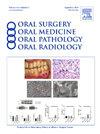Solitary fibrous tumor of the buccal mucosa: case presentation and review of the literature
IF 1.9
3区 医学
Q2 DENTISTRY, ORAL SURGERY & MEDICINE
Oral Surgery Oral Medicine Oral Pathology Oral Radiology
Pub Date : 2025-07-21
DOI:10.1016/j.oooo.2025.04.020
引用次数: 0
Abstract
Introduction
Solitary fibrous tumor (SFT) occurs primarily in adults and is considered an entity of intermediate potential. Most cases follow a benign clinical course, with select tumors exhibiting malignant features. While SFT can occur at any site, the pleural lining of the thorax is the most common. Occurrence in the oral cavity is infrequent. Although histopathology is diverse from case to case, consistent characteristics include a monomorphic spindle cell population in a fibrous stroma with endothelial-lined channels of differing caliber that may show a stag-horn appearance. Treatment is dependent upon the clinical and microscopic features with complete excision and clinical follow-up being appropriate in most cases. We report an SFT of the right buccal mucosa in a female of 29 years and review the literature.
Materials and Methods
A 29-year-old female presented with an oral lesion that had gradually increased in size over 6 months. A nonpainful 1.5 × 1.5 cm spherical mass was identified on the right buccal mucosa.
Results
Incisional biopsy was performed under local anesthesia and the tissue was submitted to pathology. Microscopic features included an intact surface mucosa and underlying moderately-dense proliferation of monomorphic spindle cells possessing inconspicuous cytoplasmic borders arranged haphazardly in a fibrovascular stroma. The spindle cells stained strongly positive for CD-34 and STAT-6 and were negative for S-100 protein, confirming a diagnosis of SFT. The patient underwent excision under general anesthesia. Final histopathology showed tumor-free margins. The patient is free of disease 4-months postoperatively. The overall features of this case (patient age of less than 55 years, tumor size less than five cm, and few mitotic figures), predict a favorable clinical course based on Demiccio and colleagues’ criteria.
Conclusion
The clinical, histopathological, and immunohistochemical features of an SFT in a 29-year-old female are presented and the literature is reviewed. Management and follow-up are discussed.
口腔粘膜孤立性纤维性肿瘤:病例报告及文献复习
孤立性纤维性肿瘤(SFT)主要发生于成人,被认为是一种中等潜能的肿瘤。大多数病例临床表现为良性,部分肿瘤表现为恶性。虽然SFT可以发生在任何部位,但胸膜衬里是最常见的。发生在口腔是罕见的。尽管组织病理学因病例而异,但一致的特征包括纤维间质中单形梭形细胞群,内皮细胞内衬不同口径的通道可能呈现鹿角状外观。治疗取决于临床和显微特征,在大多数情况下,完全切除和临床随访是适当的。我们报告一例29岁女性右颊粘膜SFT,并回顾相关文献。材料与方法一名29岁女性,口腔病变在6个月内逐渐增大。右侧颊黏膜发现一无痛的1.5 × 1.5 cm球形肿块。结果局麻下行切口活检,组织病理检查。显微特征包括完整的表面粘膜和潜在的中等密度的单形梭形细胞增生,这些细胞具有不明显的细胞质边界,在纤维血管间质中随意排列。纺锤体细胞CD-34和STAT-6呈强阳性,S-100蛋白呈阴性,确诊为SFT。病人在全身麻醉下接受了手术切除。最终组织病理学显示无肿瘤边缘。术后4个月无疾病。该病例的总体特征(患者年龄小于55岁,肿瘤大小小于5cm,有丝分裂图较少),根据Demiccio及其同事的标准,预测了一个良好的临床过程。结论报告1例29岁女性SFT的临床、组织病理学和免疫组织化学特征,并复习相关文献。讨论了管理和后续措施。
本文章由计算机程序翻译,如有差异,请以英文原文为准。
求助全文
约1分钟内获得全文
求助全文
来源期刊

Oral Surgery Oral Medicine Oral Pathology Oral Radiology
DENTISTRY, ORAL SURGERY & MEDICINE-
CiteScore
3.80
自引率
6.90%
发文量
1217
审稿时长
2-4 weeks
期刊介绍:
Oral Surgery, Oral Medicine, Oral Pathology and Oral Radiology is required reading for anyone in the fields of oral surgery, oral medicine, oral pathology, oral radiology or advanced general practice dentistry. It is the only major dental journal that provides a practical and complete overview of the medical and surgical techniques of dental practice in four areas. Topics covered include such current issues as dental implants, treatment of HIV-infected patients, and evaluation and treatment of TMJ disorders. The official publication for nine societies, the Journal is recommended for initial purchase in the Brandon Hill study, Selected List of Books and Journals for the Small Medical Library.
 求助内容:
求助内容: 应助结果提醒方式:
应助结果提醒方式:


